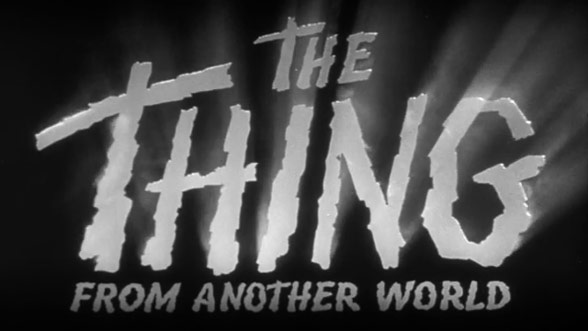Where John Carpenter fans might find Who Goes There? familiar, like coming home after a long absence, its 1951 adaptation is more like viewing the story through a funhouse mirror: anything recognizable is distorted, and
Where John Carpenter fans might find Who Goes There? familiar, like coming home after a long absence, its 1951 adaptation is more like viewing the story through a funhouse mirror: anything recognizable is distorted, and the rest is utterly alien. All the characters are new, with no figure easily recognizable as Macready, Blair, Norris, or Dr. Copper. The setting has been shifted from an Antarctic research base to a military installation in Alaska. There are still scientists here, polar researchers capable of explaining the monster to the audience, but the protagonists are soldiers. The addition of a romantic subplot almost wholly obliterates the Lovecraftian feel Campbell maintained in his novella. It is an alien landscape.
But while The Thing from Another World is a very loose adaptation, it doesn’t depart from its source material entirely. Both the novella and the 1982 movie hint at a scene which they refuse to depict: the discovery of the alien ship buried in the ice. Here, a large chunk of the runtime is devoted to the crash, the flyover in which they find the vessel’s trail through the ice and snow, and the revelation that the single fin jutting out grayly against the barren, white waste belongs not to an experimental Russian airship, but a flying saucer. The last scene is chilling. In the book, Macready describes their attempt to excavate the craft. The depiction of that moment here is both spectacular and faithful.
The beginning is worthy of any 1950’s scifi classic, but what follows has attracted unlimited scorn from fans of the wider mythos. In place of a shape-shifting, shoggothic abomination, the creature thawed from the ice turns out to be a discount Frankenstein’s monster. It is huge and shambling, but hardly gruesome, and totally incapable of mimicry. The paranoia of guessing who around you might be the Thing is totally absent, replaced by a more Jaws-like fear of something lurking in the darkness, around the corner, just offscreen. He appears suddenly and violently, and vanishes just as quickly.
But in losing our shoggoth, we seem to regain another Lovecraftian element: traces of the Elder Thing. Just as that alien race in At the Mountains of Madness straddled the line between animal and vegetable, so the “thing from another world” is revealed to be more closely related to plant life that the lumpy human he resembles. This disorienting stroke of cosmicism brings with it certain new dangers, not quite the same as those of either of its literary predecessors. Whether these new tropes have been done better by others is left to the reader’s judgment–the movie is worth watching, and better left unspoiled.
Another distinctive is more thematic: the tension between soldiers and scientists. For H.P. Lovecraft, the word “scientist” is a badge of honor, something he gives the Elder Things to humanize them. The quest for knowledge, dangerous as it is, may be what gives life dignity for Lovecraft. In Campbell’s novella, scientists can also be men of action, mighty heroes capable of risking themselves for one another and for all mankind. But in The Thing from Another World, scientists are dangerous. Their thirst for knowledge drives them to risk the very survival of humanity rather than destroy the alien creature. It is soldiers, fiercely practical and human, who stand up to both beast and scientists, and save the day. Perhaps this is simply a difference in the storytellers’ personalities. On the other hand, maybe the shift in attitude is due to the new dawn of a nuclear age. Science had become less a tool of deliverance than of apocalypse.
Whatever nuclear gloom might hang over The Thing from Another World, its ending is far more upbeat than other versions of the story. It does leave us with a chilling final line, but enough stalwart heroes survive that the threat doesn’t seem as large as it might. Overall, the movie does not age terribly well, but it has several good elements, and one stunning action scene which this review leaves completely unspoiled. If you watch it, and you should, you will certainly recognize the moment. It required actors and crew to perform a particular kind of stunt for the first time in film history, and it pays off. It is things like that which make the laughable threat of a “super carrot” worth enduring. Go see it, if you can.
Next week our journey will reach its end at last, as we return to the South Pole for John Carpenter’s The Thing
